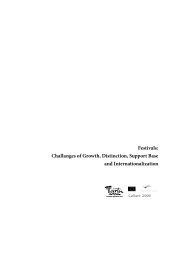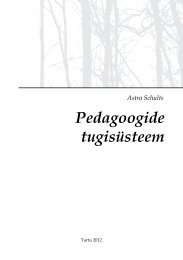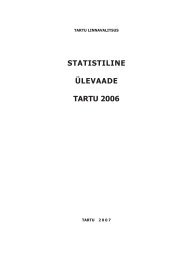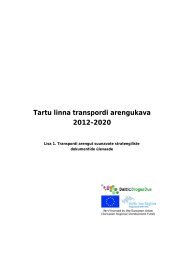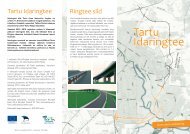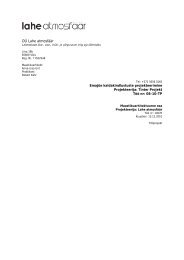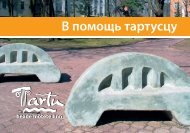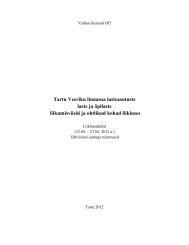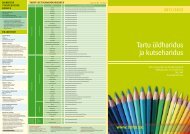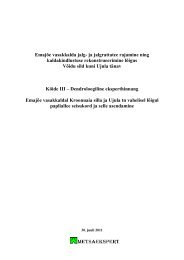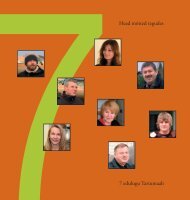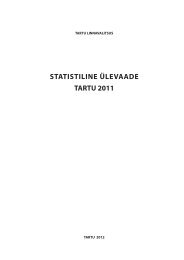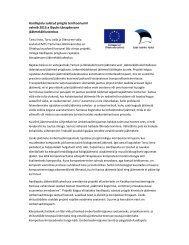Tartu's cultural institutions and organisations
Tartu's cultural institutions and organisations
Tartu's cultural institutions and organisations
Create successful ePaper yourself
Turn your PDF publications into a flip-book with our unique Google optimized e-Paper software.
12 13<br />
National Museums<br />
Tartu Toy Museum<br />
Wed-Sun 11-18<br />
phone +372 746 1777<br />
Lutsu 8<br />
www.mm.ee<br />
The Toy Museum is located in the centre of Tartu’s<br />
Old Town in an old wooden building <strong>and</strong> gives the<br />
adults a chance to go back into their childhood,<br />
<strong>and</strong> the children the chance to relate to dolls in a<br />
different way. A permanent exhibition of dolls <strong>and</strong><br />
toys throughout the ages is complemented by the<br />
playing <strong>and</strong> h<strong>and</strong>icraft room; <strong>and</strong> also temporary<br />
exhibitions, courses <strong>and</strong> children’s events.<br />
Cinema <strong>and</strong> Theatre Puppet House<br />
of the Tartu Toy Museum<br />
Wed-Sun 11-18<br />
phone +372 746 1778<br />
Lutsu 8<br />
www.mm.ee<br />
The Cinema <strong>and</strong> Theatre Puppet House of the<br />
Toy Museum displays the puppets <strong>and</strong> props of<br />
the Estonian animated movies made in the last<br />
half a century. There is also an introduction into<br />
the puppet theatre history; a chance to see animated<br />
cartoons; a view into the process of theatre<br />
puppet production; an overview of the technical<br />
predecessors to the current cinema; <strong>and</strong> the<br />
chance to test some of the simpler optical tricks.<br />
Tartu Art Museum<br />
Wed-Sun 11-18<br />
phone +372 744 1080, +372 744 1920<br />
Raekoja plats 18<br />
www.tartmus.ee<br />
The Tartu Art Museum was opened in 1940 <strong>and</strong> today<br />
has one of Estonia’s finest art collections of painted,<br />
graphic, sculpted <strong>and</strong> multimedia works from mostly<br />
Estonian, but also Russian <strong>and</strong> Western European artists.<br />
The art fans can also peruse the art history archive,<br />
film <strong>and</strong> photo collection, <strong>and</strong> library. The Leaning<br />
House by the Town Hall Square hosts over 10 different<br />
exhibition projects during a year <strong>and</strong> the accompanying<br />
lectures <strong>and</strong> practical activities are organized by<br />
the education centre. The traditional exhibition “The<br />
Tales of Tartu’s Art”, already the eighth permanent exhibition,<br />
introduces the city’s art development history<br />
through the one <strong>and</strong> a half century of the artists <strong>and</strong><br />
groups who studied, taught or were active in Tartu.<br />
Estonian Literary Museum<br />
Mon-Thu 9-17, Fri 9-16.30<br />
phone +372 737 7700<br />
Vanemuise 42<br />
www.kirmus.ee<br />
The Estonian Literary Museum is a national scientific<br />
<strong>and</strong> development institution administrated by the<br />
Ministry of Education <strong>and</strong> Research, that also works<br />
as the central archive of national literature <strong>and</strong> folklore,<br />
<strong>and</strong> the national archive library. The main goal of<br />
the Literary Museum is to guarantee the preservation<br />
of national <strong>cultural</strong> source materials necessary for the<br />
continuation of the national identity <strong>and</strong> the social<br />
memory, intellectual freedom <strong>and</strong> the wholesome<br />
<strong>cultural</strong> development; <strong>and</strong> also to conduct research<br />
<strong>and</strong> communication according to the scientific community’s<br />
<strong>and</strong> society’s needs <strong>and</strong> interests.<br />
The Literary Museum has six subsections: the Archival<br />
Library, the Estonian Folklore Archives, the Estonian<br />
Cultural History Archives, the Department of Folklore,<br />
the Department of Ethnomusicology, <strong>and</strong> the Administrative<br />
Department. The three structural units manage<br />
the large, unique folk <strong>cultural</strong> collections: the<br />
national heritage collection, the <strong>cultural</strong> historical<br />
source material collection, the folklore collection.



